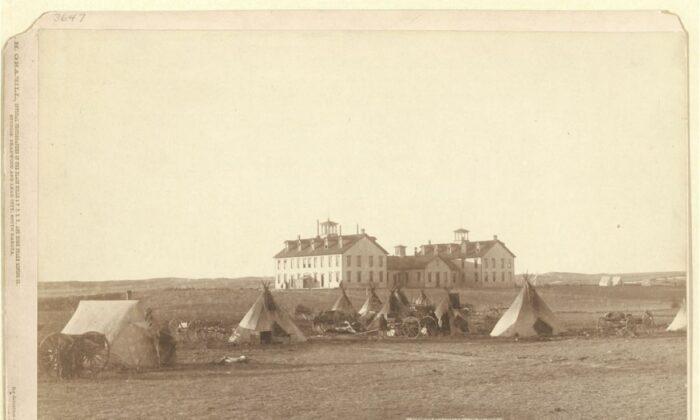Erasing culture, pulling children away from their parents, and disregarding the emotional needs of children. These tactics could be pulled from today’s headlines, but they are the tried-and-true education policies the United States has admitted to using for 150 years as a tool to force the assimilation of Native Americans, and specifically to acquire Indian territorial land.
The BIA says the government used the education of children to “replace the Indian’s culture with our own.” This, the report says, was considered “the cheapest and safest way of subduing the Indians, of providing a safe habitat for the country’s white inhabitants, of helping the whites acquire desirable land, and of changing the Indian’s economy so that he would be content with less land.”
The report was requested last year by Interior Secretary Deb Haaland, a member of the Pueblo of Laguna in New Mexico. She is the first Native American to serve as a cabinet secretary.

Haaland asked for an investigation into the loss of lives and lasting consequences of the Federal Indian boarding school system.
“This report shows for the first time that between 1819 and 1969, the United States operated or supported 408 boarding schools across 37 states [or then-territories], including 21 schools in Alaska and seven schools in Hawaii,” Bryan Newland, assistant secretary of Indian Affairs, wrote in a letter introducing the report.
Another report expanding the investigation is planned.
“The Federal Indian boarding school policy was intentionally targeted … at children to assimilate them and, consequently, take their territories,” Newland said.
Taken from Parents
Congress ended treaty-making with Indian tribes in 1871 and started using statutes, executive orders, and agreements to regulate Indian Affairs, the report says. Around that time, Congress enacted laws to compel Indian parents to send their children to school and to authorize the Secretary of the Interior to issue regulations to secure the enrollment and regular attendance of eligible Indian children, whom the government considered wards of the government.“Many Indian families resisted the assault of the Federal Government on their lives by refusing to send their children to school,” the 1969 Kennedy Report, quoted in the current report, said.
Under the Act of March 3, 1893, Congress authorized the Secretary of Interior to withhold rations, including those guaranteed by treaties, to Indian families whose children between ages 8-21 did not attend schools. No school meant no money or food for the family.
“There is ample evidence in federal records demonstrating that the United States coerced, induced, or compelled Indian children to enter the Federal Indian boarding school system,” the report says.
The Department of Interior moved children to off-reservation boarding schools without parental consent, often in distant states where children endured “rampant physical, sexual, and emotional abuse; disease; malnourishment; overcrowding; and lack of health care,” the report says.

Once at boarding school, children were given English names and clothing. Their hair was cut, and they were prevented from using their native language, religion, and cultural practices. Children were sorted into units to perform military drills; performed labor and were subject to corporal punishment.
At the Kickapoo Boarding School in Kansas, when children ran away from school, officials went looking for them and brought them back to school where they faced “a whipping administered soundly and prayerfully,” in front of other students to warn them not to flee, the report says. This same school had children sleeping three to a bed. The schools were typically overcrowded, the report shows.
The intent of all this was to permanently break family ties and prevent students from returning to the reservations. The system produced intergenerational trauma, the report says.
Lacking Education
Work done by children in these boarding schools would likely be a violation of child labor laws in most states, said the 1928 Meriam Report, prepared at the request of the then-Secretary of the Interior.Focused on vocational training, the government adopted a half-time plan, with students spending half the day in academic subjects and the remaining time in work. They tended to farm animals, the report says, and worked in lumbering, on the railroad, carpentry, blacksmithing, fertilizing, irrigation system development, well-digging, making furniture including mattresses, tables and chairs, cooking, laundry, ironing services, and garment-making.
The 2022 report shows that, in 1857 at the Winnebago Manual Labor Schools in Nebraska, the girls made 550 garments for themselves and the boys attending the school, and 700 sacks for farm use. In 1903, a report from the Mescalero Boarding School in New Mexico showed the Mescalero Apache boys sawed over 70,000 feet of lumber, 40,000 shingles, and made more than 120,000 bricks.
Paid for With Money Meant for Indians
The schools were given operation money annually, but according to the report, the federal government likely also used money held in tribal trust accounts and proceeds of the sale tribal land to run the schools.“It is apparent that proceeds from cessions of Indian territories to the United States through treaties—which were often signed under duress—were used to fund the operation of Federal Indian boarding schools. As a result, the United States’ assimilation policy, the Federal Indian boarding school system, and the effort to acquire Indian territories are connected,” the report says.
The United States government paid missionary church groups to run the programs. It had contracts, the report says, with the American Missionary Association of the Congregational Church, the Board of Foreign Missions of the Presbyterian Church, the Board of Home Missions of the Presbyterian Church, the Bureau of Catholic Indian Missions, and the Protestant Episcopal Church.
Schools had Grave Sites

Most schools don’t need a cemetery, but these schools did. An initial investigation of 19 schools found over 500 student deaths.
“The intentional targeting and removal of … children to achieve the goal of forced assimilation of Indian people was both traumatic and violent,” the report says. “The department found hundreds of Indian children died throughout the Federal Indian boarding school system and it believes continued investigation will reveal the approximate number of Indian children who died at these schools to be in the thousands or tens of thousands.”
The department’s research has identified at least 53 different burial sites across the school system; some marked, others unmarked or poorly maintained.
“The deaths of Indian children while under the care of the federal government, or federally-supported institutions, led to the breakup of Indian families and the erosion of tribes,” the report says.
Recommendations
The report makes recommendations including funding a full investigation. Congress appropriated $7 million in new funds through fiscal year 2022, through the Consolidated Appropriations Act. The report asks to expand the investigation with continued funding for fiscal year 2023.It also suggests identifying surviving boarding school attendees, and formally documenting their historical accounts and experiences, including studying current impacts such as health status, including substance abuse and violence.
It asks to protect details of gravesites from being made public under the Native American Graves Protection and Repatriation Act, by making information exempt from Freedom of Information Act.
It also recommends the advancement of native language revitalization by funding the development of programs supporting native language revitalization in both Bureau of Indian Education funded schools, and non-BIE schools.
The report calls for the promotion of Indian health research by funding scientific studies on lasting health impacts.
And the report suggests recognizing the generations of children who experienced the Federal Indian boarding school system with a federal memorial.





